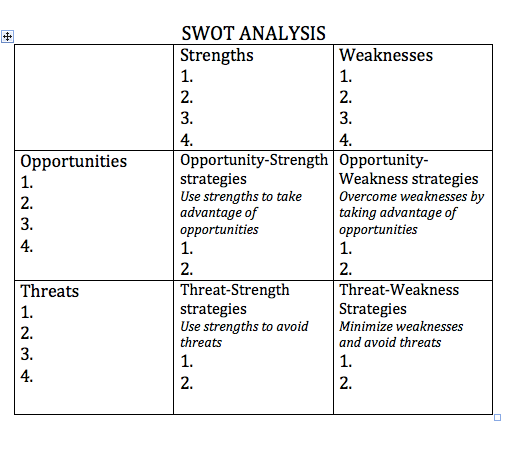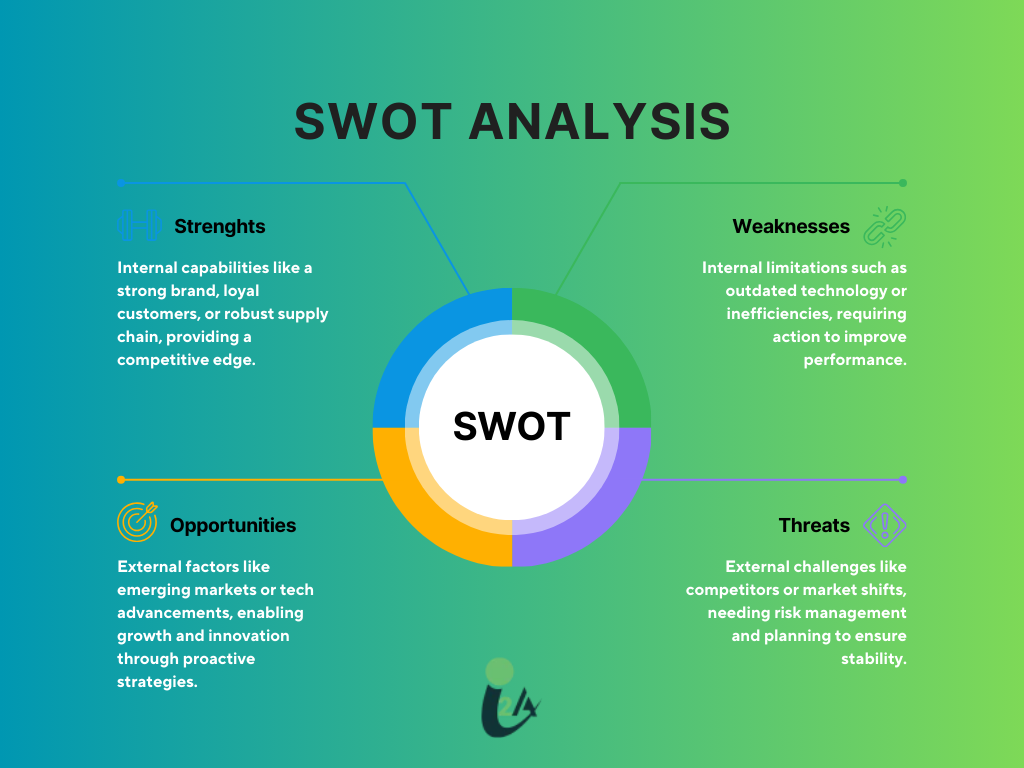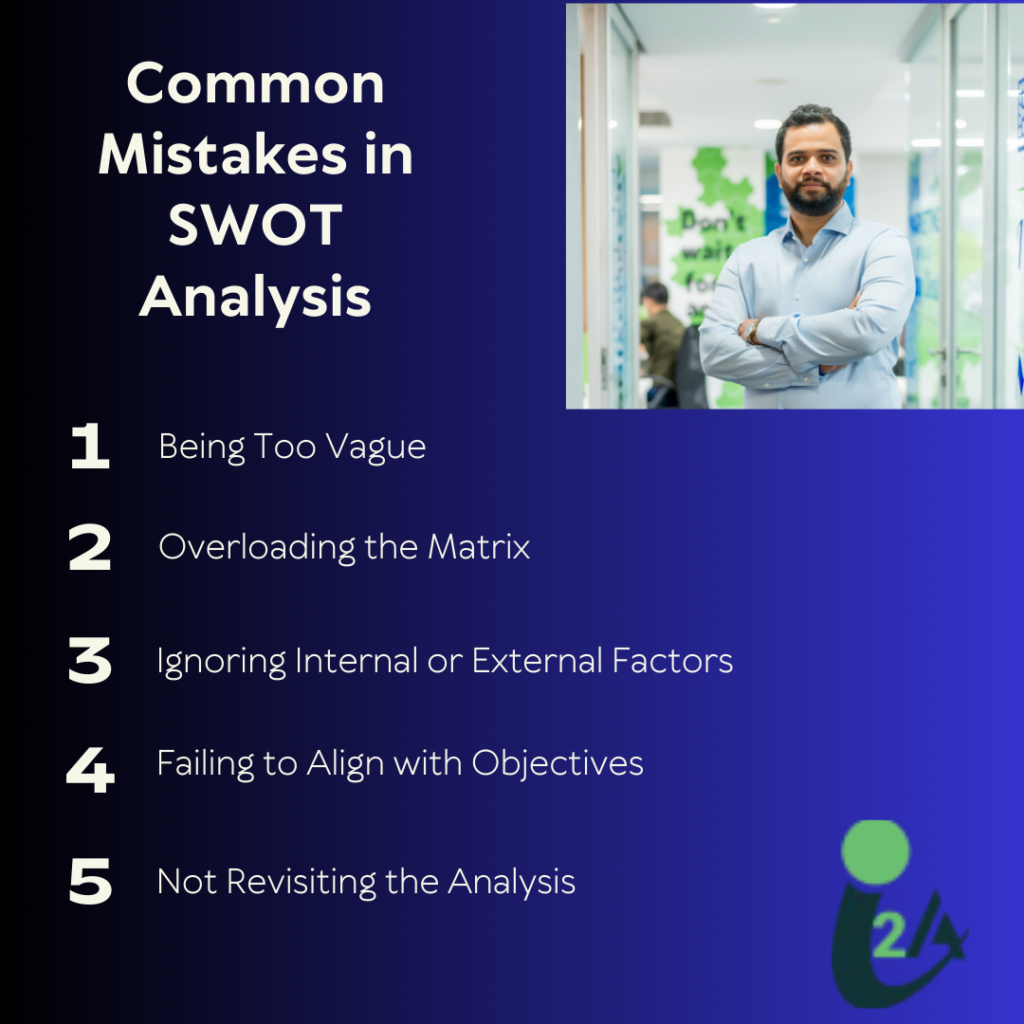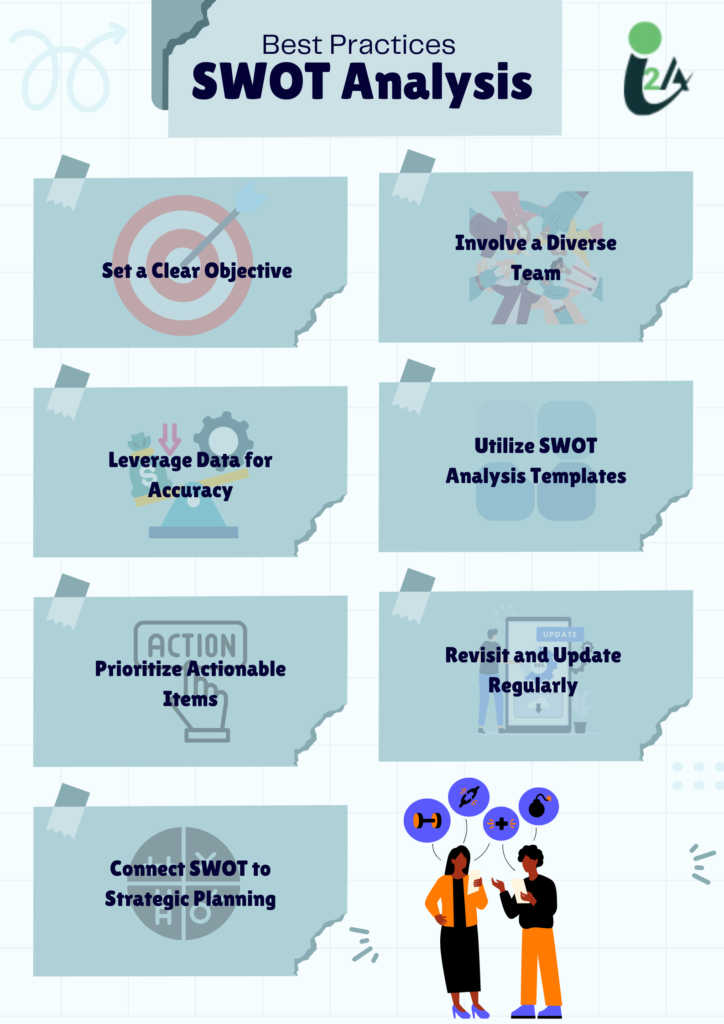What is SWOT Analysis?
SWOT analysis stands for Strengths, Weaknesses, Opportunities, and Threats, is a strategic planning technique used to evaluate a business’s internal and external environment.
SWOT analysis helps organizations identify key factors influencing their business performance and market position. By examining both internal factors (strengths and weaknesses) and external factors (opportunities and threats), SWOT analysis provides a comprehensive view of the broader business environment.
The significance of SWOT analysis lies in its ability to guide strategic planning and decision-making. It allows businesses to identify strengths that provide a competitive advantage, address weaknesses that may hinder growth, leverage opportunities to capture emerging markets, and prepare for external threats. This tool not only supports corporate planning but also fosters innovative ideas for long-term success.
SWOT analysis is commonly conducted using a visual tool called the SWOT Matrix. This matrix is a simple, four-quadrant grid that categorizes insights into strengths, weaknesses, opportunities, and threats. Each section helps businesses organize their findings in a structured format, enabling easier analysis and actionable outcomes. The SWOT analysis matrix is widely used across industries due to its clarity and practicality.
In any organization, there are controllable internal elements, such as resources and internal processes, and uncontrollable external forces, like market trends and emerging competitors.
The SWOT framework enables businesses to analyze these factors effectively, balancing internal strengths and weaknesses with external opportunities and threats, to develop strategies that enhance business performance.
The scope of SWOT analysis extends beyond identifying business challenges; it serves as a foundation for strategic planning. It is versatile enough to be used by small startups, large corporations, and even law firms, helping them craft tailored approaches to achieve specific goals. From evaluating a company’s strengths to adapting to market shifts, a good SWOT analysis is a cornerstone of competitive positioning and sustainable growth.
“Your business do not exist in a vaccum. There is a constant interaction of enternal and internal factors that are shaping business response. Be it changes in customer behaviour, a sudden move by the competitor, or policy change by the government. Running a business is all about continuously scanning the business environment.”
Amit Chauhan-Founder and CEO, I2A Technologies Private Limited
Components of the SWOT Matrix

The SWOT matrix is a strategic planning tool that organizes a company’s strengths, weaknesses, opportunities, and threats into a four-quadrant chart. The top two quadrants focus on internal factors—strengths and weaknesses—while the bottom two address external factors—opportunities and threats.
These quadrants interrelate, as strengths can be leveraged to seize opportunities, and weaknesses must be mitigated to reduce vulnerability to external threats.
The matrix is a visual representation of key business factors that influence performance and strategic direction. For example, identifying internal strengths such as a loyal customer base or strong brand reputation can guide plans to capture emerging markets.
Understanding threats like market shifts or emerging competitors helps businesses craft proactive strategies. A well-executed SWOT analysis matrix ensures that businesses are prepared for both current and future challenges.
Internal Factors (Strengths and Weaknesses)
Internal factors are controllable elements within an organization that shape its strengths and weaknesses. Strengths represent the company’s competitive advantages, such as technical expertise, innovative ideas, financial resources, or a robust supply chain. These factors help businesses achieve a stronger market position and gain an edge in the competitive landscape.
Conversely, weaknesses are internal shortcomings that can hinder business performance. These may include outdated internal processes, insufficient human resources, or gaps in technical expertise.
Addressing internal weaknesses is crucial for improving efficiency and ensuring sustainable growth. By analyzing these internal capabilities, businesses can align their operations with broader strategic goals.
External Factors (Opportunities and Threats)
External factors, shaped by the broader business environment, include elements outside the company’s control that influence opportunities and threats. Opportunities often arise from favorable market trends, emerging markets, or technological advancements that businesses can capitalize on. For instance, changes in consumer behavior or the adoption of innovative products in an external environment can open new avenues for growth.
Threats, on the other hand, include external risks such as economic instability, regulatory changes, or competition from new entrants. These external forces can negatively impact the business if not anticipated.
Conducting a SWOT analysis helps businesses identify these external opportunities and threats, enabling them to adapt their business strategy and maintain a competitive edge in the face of uncertainty.
“Internal factors can be handled with proactive measures, but in a business strategy what surprises you is the suddenness of external factors. For a digital marketing company or an online sales based businesses a Google Core Update can trip your sales metrics into a tizzy and you cannot be prepared for it. For me, all business strategy is about handling the external factors that are uncontrollable.”
Amit Chauhan-Founder and CEO, I2A Technologies Private Limited
Deep Dive into Each Aspect of SWOT

Strengths
Strengths are the internal capabilities and resources that provide a business with a competitive advantage. They reflect what a company does well, such as a strong brand reputation, technical expertise, or a loyal customer base. Identifying strengths helps businesses leverage these assets to enhance their market position.
For example, a robust supply chain ensures consistent delivery, and unique intellectual property (IP) protects innovations from competitors. Recognizing and optimizing these strengths allows businesses to capitalize on opportunities and maintain a competitive edge in a dynamic market.
Weaknesses
Weaknesses are internal factors that hinder a company’s performance or growth potential. These could include outdated technology, lack of skilled personnel, or inefficient internal processes. Identifying weaknesses is essential for addressing vulnerabilities and improving overall business performance.
Businesses can address weaknesses by conducting internal audits, gathering feedback from stakeholders, and investing in areas requiring improvement. By turning weaknesses into opportunities for growth, companies can strengthen their foundation and prepare for long-term success.
Opportunities
Opportunities are external factors that a business can leverage to drive growth and innovation. They arise from favourable market trends, emerging markets, technological advancements, or shifts in consumer behavior. Businesses can use these openings to expand their market share and enhance profitability.
Effective opportunities require thorough market research and trend analysis. Staying attuned to external forces allows companies to act quickly, positioning themselves as leaders in new or evolving markets. Recognizing opportunities is key to unlocking potential in the broader business environment.
Threats
Threats are external challenges that can disrupt business operations or hinder growth. These may include economic downturns, new competitors, regulatory changes, or shifts in consumer preferences. Left unaddressed, threats can significantly impact a company’s market position and revenue.
Mitigating threats requires proactive planning. Businesses can use risk assessments, scenario planning, and competitive analysis to prepare for external forces. By addressing threats early, companies can protect their assets and maintain stability in uncertain environments.
SWOT Framework for a Cloud Business
Strengths
For a cloud business, strengths include robust technical expertise, scalable infrastructure, and innovative solutions tailored to customer needs. A strong brand reputation and a loyal customer base further enhance competitive positioning.
Leverage these internal capabilities by focusing on customer retention and expanding service offerings. Use your strengths to differentiate your services, such as emphasizing the reliability of your infrastructure and advanced features like AI integration.
Weaknesses
Common weaknesses for cloud companies include high operational costs, dependence on third-party vendors, and potential gaps in data security. Limited market presence or lack of technical expertise in emerging technologies may also hinder growth.
Conduct regular internal audits to identify and address vulnerabilities. Strengthen internal processes, invest in employee training, and explore partnerships to mitigate operational costs.
Enhancing cybersecurity measures and building a robust compliance framework can also improve business performance.
Opportunities
Opportunities in the cloud industry arise from increasing demand for cloud solutions, the adoption of hybrid models, and emerging markets. Technological advancements and growing reliance on remote work create additional avenues for growth.
Focus on market research and consumer trends to identify potential opportunities. For instance, target industries adopting cloud solutions, such as healthcare and finance.
Use a strong SWOT analysis framework to align your strategic planning with market demands, ensuring your business captures these opportunities effectively.
Threats
Threats to a cloud company include intense competition, rapid technological changes, and regulatory challenges. Economic uncertainty and evolving consumer behavior can also disrupt business operations. External threats like data breaches or system downtimes may tarnish a company’s reputation.
Proactively invest in competitive analysis and cybersecurity to safeguard your position. Diversify offerings to counter market shifts and maintain compliance with regulatory standards.
Building contingency plans for economic fluctuations and emphasizing transparency with customers can mitigate potential risks.
Steps to Conduct Swot Analysis
Step 1: Define the Objective
Begin by clearly outlining the purpose of the SWOT analysis. Whether it’s for strategic planning, launching a new product, or improving business performance, having a clear objective ensures the analysis remains focused and actionable.
Step 2: Gather a Team and Brainstorm
Bring together stakeholders, including team members from different departments, to ensure diverse perspectives. Collaborative brainstorming helps identify internal strengths and weaknesses as well as external opportunities and threats. Tools like a SWOT analysis template can organize ideas effectively.
Step 3: Identify Internal Factors (Strengths and Weaknesses)
Evaluate internal factors that impact business performance. Strengths could include internal capabilities like technical expertise, a loyal customer base, or financial resources. Weaknesses might involve gaps in human resources, outdated processes, or insufficient technological advancement. These internal factors are within your control and should be prioritized for optimization.
Step 4: Analyze External Factors (Opportunities and Threats)
Examine the broader business environment for external factors like market trends, emerging competitors, or regulatory changes. Opportunities such as new markets or technological advancements can be leveraged, while threats like economic instability or evolving consumer behavior must be mitigated. External forces are beyond your control but require strategic responses.
Step 5: Organize Findings into a SWOT Matrix
Use a SWOT matrix or a free SWOT analysis template to categorize your findings into strengths, weaknesses, opportunities, and threats. This structured format allows for a clearer understanding of how these elements interrelate and influence business strategy.
Step 6: Prioritize and Develop Strategies
Evaluate the SWOT analysis to identify key priorities. Focus on leveraging strengths to seize opportunities, addressing weaknesses to mitigate threats, and aligning these insights with your company’s broader strategic goals.
Step 7: Implement and Monitor
Develop actionable plans based on the analysis and integrate them into your strategic planning process. Regularly revisit the SWOT analysis to adapt to changes in internal factors or the external environment, ensuring ongoing relevance and effectiveness.
Common Mistakes and Best Practices for SWOT Analysis

Common Mistakes in SWOT Analysis
- Being Too Vague: Generic or poorly defined elements like “good service” or “strong brand” fail to provide actionable insights. Ensure each point in the SWOT matrix is specific and measurable to guide meaningful strategies.
- Overloading the Matrix: Including too many factors dilutes focus and hinders decision-making. Prioritize key strengths, weaknesses, opportunities, and threats that have the most significant impact on business performance.
- Ignoring Internal or External Factors: A one-sided analysis, focusing only on internal factors or external threats, results in an incomplete picture. A balanced approach ensures businesses address both controllable elements and external forces.
- Failing to Align with Objectives: Conducting a SWOT analysis without a clear purpose leads to scattered findings. Align the analysis with specific goals, such as market positioning, competitive analysis, or new product launches.
- Not Revisiting the Analysis: SWOT is a dynamic tool, not a one-time exercise. Ignoring market trends, emerging competitors, or internal changes can render an analysis outdated and ineffective.
Best Practices for SWOT Analysis

- Set a Clear Objective: Define what the analysis aims to achieve, such as improving business strategy, identifying market trends, or enhancing competitive positioning. A well-defined goal keeps the process focused.
- Involve a Diverse Team: Engage individuals from various departments to ensure diverse perspectives. This approach enhances the identification of strengths, weaknesses, and external opportunities or threats.
- Leverage Data for Accuracy: Use reliable data sources, including customer feedback, financial reports, and market research, to support your findings. Data-driven insights result in a more effective SWOT analysis.
- Utilize SWOT Analysis Templates: A free SWOT analysis template simplifies the process, offering a structured way to organize insights. Templates help streamline the brainstorming process and ensure clarity.
- Prioritize Actionable Items: Focus on key factors that can drive significant change or improvement. For example, align strengths with opportunities to maximize competitive advantages and address weaknesses to mitigate threats.
- Revisit and Update Regularly: Treat SWOT analysis as a living document. Regularly revisiting and updating it ensures the business remains aligned with evolving internal factors and the external environment.
- Connect SWOT to Strategic Planning: Integrate findings from the SWOT analysis into the company’s broader strategic planning process. This ensures that the analysis drives tangible outcomes and informs critical decisions.
Conclusion
SWOT analysis is a dynamic strategic planning tool that examines both internal and external factors. By identifying key strengths, weaknesses, opportunities, and threats, businesses can develop robust strategies that adapt to evolving market conditions and drive long-term growth. The availability of free SWOT analysis templates online makes the process accessible and efficient for businesses of all sizes.
About:
Amit Chauhan is a multiprenuer who is also a Founder and CEO of I2A Technologies Private Limited. He is a doer who is fond of building businesses and robust business models. His mantra of success is to transform “Ideas” to “Action” by applying practical business concepts and rich experience.
In this article Mr. Amit Chauhan has shared his practical wisdom in utilizing the management tools to track and evaluate your business strategies.


 Steve Smith
Steve Smith 


